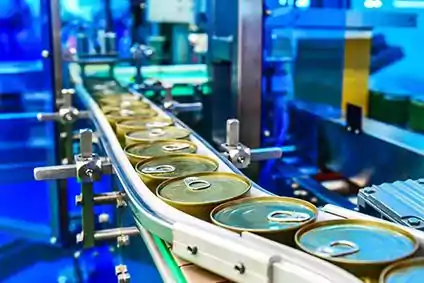Contents
Consumer packaged goods (CPG) companies are constantly on the lookout for shifts in shoppers’ demands and tastes. Whether a trend is emerging or fading, CPG companies must adjust their products accordingly. By using AI in CPG R&D, companies are getting products from conception to commercialization faster and delighting consumers.
AI can help CPG R&D teams optimize supply chains, advance sustainability and strengthen loss prevention. But perhaps the biggest potential for AI is accelerating product innovation so companies can beat competitors to market.
Learn more about the R&D challenges faced by the CPG industry and how enterprise AI can help. We’ll also explore common R&D use cases for artificial intelligence in CPG companies.
8 common CPG R&D challenges
These CPG AI advances arrive at a critical moment, with 85% of product launches failing within two years, according to a Foodpairing report.
Developing the next big thing in CPG isn’t easy. Behind every successful product launch are countless hours of R&D investigation, experimentation, trial and error, and retesting. Even the most experienced companies can struggle to invent the future. Here are some of the challenges enterprise CPG organizations face during R&D.
Cost pressures
Countless CPG R&D teams face rising costs and budgets that don't keep pace. This increase in expenses has many sources, including the need for advanced materials, sophisticated technology and heightened standards for CPG innovation and sustainability. R&D departments must increasingly do more with less while prioritizing which projects truly matter based on resources and market demand.
Efficient cost management in this context requires more than cost-cutting; it’s about making strategic investments that lead to long-term savings and competitive advantages.
Supply chain complexity
The intricate web of CPG suppliers, manufacturers and logistics systems is vulnerable to a variety of disruptions. Material shortages can arise because of supply constraints or geopolitical tensions, halting production lines and delaying product launches. Logistics bottlenecks can appear because of port congestion or transportation disruptions, further complicating the movement of goods and increasing costs.
Managing these diverse and often fragmented supply chains challenges companies to maintain operational control and visibility. Each additional layer of suppliers, logistics and geographic dispersion adds to the potential for disruption and confusion. CPG companies are already investing in supply chain resilience and digital transformation. Many are diversifying their suppliers and adopting technology for tracking goods and analyzing supply chain data.
Talent and skills gaps
With CPG companies stepping up R&D and increasingly selling direct to consumers, the talent landscape has shifted. According to research from The Josh Bersin Company, most CPG companies lack the diverse skill sets required to understand and meet modern consumer demands. Deficiencies include R&D, digital innovation and consumer analytics — components that Bersin calls "consumer delight skills."
Further complicating the talent landscape is the dynamic nature of CPG, including mergers and acquisitions. These changes can disrupt established teams, forcing them to keep pace with technological advancements even as they adapt to new organizational structures and strategies.
Changing consumer preferences
CPG companies need to quickly recognize and adapt to changing consumer trends. But recognizing and anticipating these shifts is difficult, especially across regions and cultures. Even if companies recognize most trends, they can’t necessarily develop new or modified products to meet every emerging need. Implementing significant product changes can be particularly difficult for CPG companies with complex supply chains and manufacturing processes.
Regulatory compliance
Multinational CPG companies face an array of regulations across geographies, including those related to raw materials, formulations and safety. Many products, especially those for human consumption, have additional labeling, marketing and import/export regulations.
Regulations are changing all the time, and companies need to track these developments and adjust their existing product and their R&D processes. For example, a new prohibition on certain raw materials could require additional testing to prove a product’s safety. Such regulations could even for companies to reformulate or discontinue a product.
Short product life cycles
AI in the CPG industry helps companies keep pace with evolving consumer trends by more quickly identifying and developing new products. These condensed timelines add pressure to R&D teams and create challenges in recouping costs before a product becomes obsolete or falls out of favor with consumers.
CPG research teams need to improve R&D efficiency through technologies like AI and machine learning so they can speed up product design, testing and market analysis. The financial implications of this are enormous. If CPG companies don’t rapidly innovate, iterate and repeat, their products will become outdated before they recover their development costs.
Product recalls
Product recalls can have serious financial and reputational consequences for any company, so taking every precaution to avoid them is a top priority. CPG companies increase their risk of recalls when they rush through product testing, lack sufficient safety measures or don’t ensure the highest possible production quality.
Duplicated efforts
Global R&D teams often operate in silos, largely unaware of parallel projects or research being conducted by their colleagues. This lack of communication and coordination creates redundant work, including teams wasting time on pathways that have already been developed — or have proven fruitless. This wastes time and resources while slowing down the CPG innovation process, as effort that could be spent on pioneering new developments is lost to redundancies.
![[STRM] Interior Image_8 common CPG R&D challenges](https://www.starmind.ai/hs-fs/hubfs/%5BSTRM%5D%20Interior%20Image_8%20common%20CPG%20R%26D%20challenges.png?width=1200&height=630&name=%5BSTRM%5D%20Interior%20Image_8%20common%20CPG%20R%26D%20challenges.png)
5 benefits of AI for CPG product development and innovation
The CPG industry is predicted to grow at a 3.5% compound annual growth rate through 2032. To realize this growth and even beat the industry average, CPG firms will need to increase their use of AI-powered tools.
While AI adoption varies by company, survey results indicate 69% of CPG and retail firms have already experienced an AI-driven increase in annual revenue. Here are other key benefits of AI in CPG.
Faster product development
One way AI speeds up product development is by automating tasks and doing them more quickly. For example, AI-powered tools can speed up data analysis of consumer preferences and the identification of consumer patterns. This helps data scientists make better recommendations about which CPG products are likely to succeed — or not.
AI-powered tools can generate faster, more accurate and higher-quality insights than humans using more manual processes. These gains reduce errors and also biases, such as confirmation bias, that influence people’s decision-making processes.
AI tools not only analyze information and generate analysis, they also connect R&D teams with existing critical information and expertise in real time. For example, Starmind enables your employees to answer questions themselves or connect with an in-house expert who’s most qualified to help. This eliminates archaic search processes, keeps subject matter experts from becoming overburdened and jump-starts employee productivity.
Another use of AI tools for CPG companies is virtual product prototypes for testing and analysis before committing to a physical production process. This saves money and allows companies to quickly iterate and move forward.
Improved product quality
Machine learning algorithms are helping companies identify which design, directions, ingredients and formulations are most likely to result in a high-quality product. Humans must evaluate these predictions, but this AI-powered step reduces time spent on exploration while helping companies focus on the most plausible possibilities.
For example, Nestlé uses AI to analyze consumption data and generate market research reports so the company quickly responds to emerging consumer preferences. Here are a few other examples: Leveraging big data related to customer feedback to optimize product formulation; analyzing ingredient selections and suggesting untried combinations; and improving product quality by optimizing development processes.
Reduced R&D costs
AI and automation offer a variety of ways for CPG companies to save on R&D costs and boost revenue. By using generative AI to its fullest, CPG and retail companies could add between $400 billion and $660 billion to global revenue.
One way genAI reduces costs is by enabling rapid prototyping, letting companies evaluate multiple designs or formulations without the traditional time and material expenditures. For example, genAI can create digital prototypes of new snack foods with different flavor profiles and nutritional compositions. R&D teams can quickly generate and analyze hundreds of potential recipes based on current health trends and consumer taste preferences, extracting the most promising options without having to undertake time-consuming and costly physical trials.
More automation
AI-powered solutions help CPG companies automate components such as quality-control testing and product inspection. This reduces the time and resources required while improving accuracy and consistency.
Meanwhile, advances in automation and AI are further streamlining data collection, analysis and decision-making and requiring less manual work by humans.
Better regulatory compliance
AI tools can help CPG companies meet legal and regulatory requirements, including during product development. The AI platform RegAsk analyzes regulatory data from governmental publications and trusted industry sources. It can alert companies to regulatory changes while providing the context needed to understand how the latest requirements affect them.
![[STRM] Interior Image_5 Benefits of AI for CPG product development and innovation](https://www.starmind.ai/hs-fs/hubfs/%5BSTRM%5D%20Interior%20Image_5%20Benefits%20of%20AI%20for%20CPG%20product%20development%20and%20innovation.png?width=1200&height=630&name=%5BSTRM%5D%20Interior%20Image_5%20Benefits%20of%20AI%20for%20CPG%20product%20development%20and%20innovation.png)
AI use cases in CPG product development
AI is affecting R&D across sectors, but it has particular promise for CPG companies. Here are some of the use cases the industry is already exploring.
Personalized and customized products
CPG companies use AI to develop personalized products in a variety of ways. Internally, companies can use data from search history, customer demographics, purchase history and other sources to glean trends. AI tools can also leverage external data, such as customer feedback, market trends and competitor analysis. Insights can also be gained from customer-facing AI tools, such as chatbots or AI-powered assistants. R&D teams can use this real-time feedback to highlight individual preferences or pain points.
Estée Lauder is using AI to enhance its product quality and accessibility for visually impaired people. The company’s voice-enabled makeup assistant mobile app relies on AI, augmented reality and machine learning to help visually impaired people use cosmetics confidently and independently.
The app analyzes makeup on the user’s face and provides voice guidance to help them create their desired look. The company collaborated with advocacy groups and accessibility and inclusivity experts to create the app, while consumer feedback will help improve the user experience and inform future R&D efforts.
Market research
Predictive analytics tools powered by AI can gauge consumer preferences by analyzing conversations on social media platforms, survey responses or other data points related to the customer experience. Brands can use this information to drive R&D efforts.
Kraft Heinz has created an AI-driven market research platform to gain insights into consumer preferences and behaviors, with product development being one of the beneficiaries. By getting better information on consumer preferences and analyzing it quickly with AI, Kraft Heinz expects to develop food products more easily.
Product testing
R&D requires extensive testing to ensure that new products or formulations deliver the intended results without negative side effects.
AI tools can automate much of this process, starting with evaluating massive amounts of test data more quickly than previous computing methods. An AI-based approach to product testing uses data science, machine learning and computer vision to spot defects and suggest design improvements before the product is released to the public.
Organizational knowledge
Most R&D organizations rely on tacit knowledge accumulated through hands-on experience, but this information can be challenging to document. These insights are invaluable, but they live mostly within the minds of individual employees, with limited ability for the organization as a whole to use them for improved innovation and efficiency.
An AI-powered expertise directory addresses this challenge by enabling CPG teams to systematically capture, organize and retrieve tacit knowledge. Such platforms use algorithms to analyze communication patterns and work outputs to identify who knows what within an organization. They can pinpoint who's worked on similar projects or overcome similar challenges.
For example, PepsiCo R&D needed to create a knowledge-centric R&D ecosystem that fostered faster innovation, decision-making and time to market. For PepsiCo R&D, the primary goal was to identify and connect high-quality subject matter experts, to reduce the risk of duplicated work, which would slow down the innovation cycle.
Starmind’s AI-powered expertise directory helped PepsiCo capture those conversations, connect employees with existing knowledge and in-house experts, resulting in greatly improved R&D project collaboration.
Using AI for CPG R&D in your enterprise organization
CPG and AI are inseparable in today’s economy, especially for accelerating R&D efforts and getting products to market. AI-powered tools can streamline the entire R&D process from ideation through product launch. These technologies empower companies to tap into vast amounts of data, connect with expert knowledge across global teams and streamline every step of the product life cycle.
If your organization is looking to harness the full potential of AI in R&D, exploring established success stories can be a great start. Learn how Mondelēz International uses AI to drive R&D growth.



